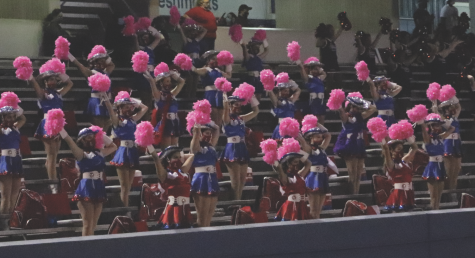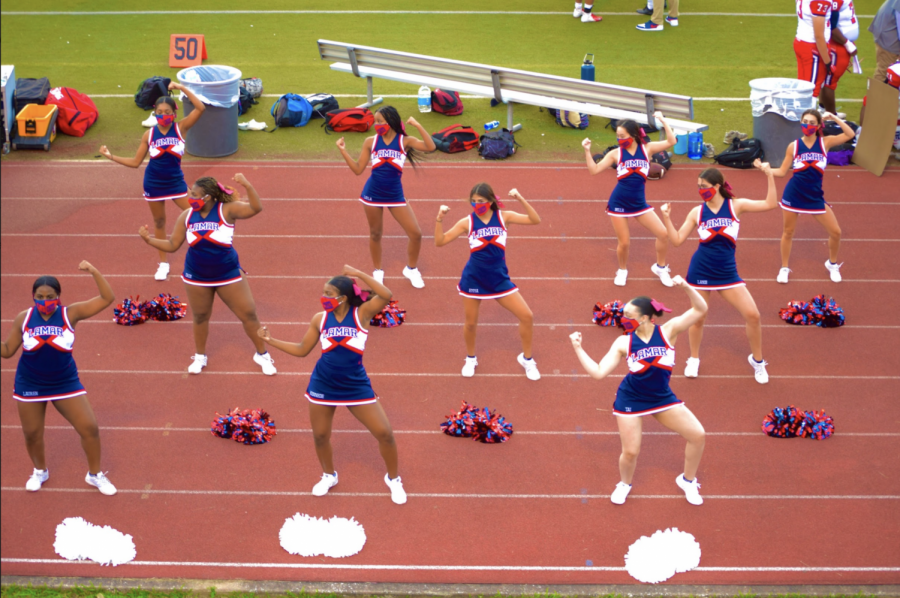Dancing with Masks: Is it an aid or restraint?
Having to wear a mask eliminates the emotional effect of visible facial expressions in a performance. This is a dilemma that dancers have to face during these trying times of COVID-19. Dancers performing with masks are having to learn creative adjustments to be able to express themselves through their dancing without using their facial expressions. Though adequately expressing oneself while dancing with a mask can be testing, many dancers have shined a light on some positive aspects that come with dancing with masks.
One such dancer who has found an upside to wearing masks while dancing is senior Elizabeth Lok, a Colonel Dance Officer for the Rangerettes. Lok has expressed that many dancers are still in an adjusting period to wearing masks.
“I am still learning the strengths and weaknesses that come with wearing a mask,” said Lok. “It’s definitely grown my stamina because even just practicing with a mask you have to breathe harder, which helps you in the long run with your stamina as a performer. This also allows you to focus more on your performance when you perform without a mask because you don’t have to focus so much on breathing and can focus more on the movements.”
Besides masks helping improve the physical strength of a dancer, wearing masks has motivated dancers to build off of each other to improve their expressions.
“Masks made us realize how much we value seeing each other’s faces because even though we can’t talk to each other during a dance, seeing each other’s expressions and faces really helps us be motivated to do better, especially for an emotional piece,” Lok said.

Senior Alice Giannoni, a Lieutenant Dance Officer for the Rangerettes, explained another reason that wearing masks while dancing can be beneficial towards an individual dancer and a team as a whole.
“When COVID is over and we can hopefully take off our masks, we will have learned so much about ourselves and the fundamentals of dancing,” said Giannoni. “Once we can add our face to our strengthened movements, we will be able to add so much more to the story because we will have improved body movements and facial expressions. A face can add so much to a dance.”
Unlike other dancers who shared their perspectives on this subject, Giannoni articulated that masks aren’t necessarily restrictive for dancers.
“I think masks can restrict a lot of newer dancers or a lot of dancers who aren’t great at moving their bodies or expressing emotions through their bodies,” Giannoni said. “A lot of dance isn’t necessarily all about faces. You can add a lot of emotion through how you move your body in a dance. If you know how to express yourself through your body, a mask won’t limit you in that way, and you should still be able to dance well. I think there are a lot of possibilities for it to help you grow in your dancing to help you learn how to express yourself better.”
On the other hand, senior Abigail Garcia, a Co-Lieutenant Colonel Dance Officer for the Rangerettes, does believe that masks can be restrictive for dancers and how their performance is perceived.
“Masks are restrictive because the audience isn’t able to see our smile as clearly or our facial expressions which is important to energize the crowd while we’re dancing,”said Garcia. “At the same time, masks also push us to be better because we have to be just as, if not even more exciting within our movements and our facials so that people can tell we are performing even with a mask on.”
Masks are restrictive because the audience isn’t able to see our smile as clearly or our facial expressions which is important to energize the crowd while we’re dancing.
— Abigail Garcia
The team is working hard to compensate for the lack of visible facial expressions during a performance as a result of the masks.
“The team is working to sharpen our movements to make them super bold and show energy through our movements so that the audience is aware that just because we have the masks on, we’re still performing to the best of our ability,” Garcia said. “The masks help us because they’re showing us that we have to do all these other things within our body to show that energy that can’t be shown through our face anymore.”
Though it’s clear that masks can have benefits for dancers and the problems that come with dancing with masks can be appropriately addressed, senior Mikala Coley, a former Rangerette dancer and currently a dancer for LDT, pointed out some aspects of dancing that can’t be done during COVID and with masks.
“Through my performances before COVID, we had competitions and were able to do a lot of group dances and large ensembles,” said Coley. “I was on Rangerettes then, so within those dances we were able to do dance moves that involved partner lifts, were able to be in close proximity of each other, and were able to feed off of each other’s movements since we were in a more compact form. As an individual dancer, I used my facial expressions to express my emotions to match my movements.”
While closer interactions with fellow dancers isn’t doable for safety reasons, Coley still believes that dancers can stand out and possibly dance even better while dancing with masks.
“I believe that wearing masks, for me at least, allows you to stand out because the audience is going to be focusing on your movements and your movements have to be able to show your emotional connection to the piece,” Coley said. “Without masks, the audience tends to rely more on facial expressions. With the masks, you are really just working to be able to tell the story in the same way and push yourself even greater because you know that you are limited without your main storytelling feature which is your face.”
Similarly to the effects of masks among dancers, wearing a mask while performing has also impacted cheerleaders and how they execute their performances.
Since COVID and the use of masks have restricted cheerleaders, senior Tai Barnes has expressed that she prefers cheering without a mask for a number of reasons.
“I prefer cheering without a mask on not only because I can breathe better, but also because I feel more comfortable with the audience, with my teammates, and seeing myself at my best potential,” Barnes said. “With masks, it’s hard to tell how a person feels at the moment which is dangerous because during some games it gets really hot and it’s hard to tell if a person isn’t feeling well since we can’t see their expressions.”
Senior Kennede Earle, another cheer captain, expanded on Barnes’ preference of cheering without a mask.
“I like cheering better without the masks on because the masks not only make it difficult for us to engage with the crowd, but also to have interactions with the band and with the Rangerettes,” said Earle.
Despite Earle’s immensely understandable preference to cheer without a mask, Earle believes that the experience of cheering with masks will still bring some benefits in the long run for cheerleaders.
“Having to cheer with masks will for sure make all of us better cheerleaders because cheering with masks has given us different advantages,” Earle said. “One, our volume towards the crowd will be much louder once we can cheer without masks because we’ve had the masks as a barrier for the sound. I also think that when we don’t have the masks on, cheerleaders will be more grateful for not having that barrier between us and the crowd so we’ll want to do more, do better, and participate in more crowd engagement.”



